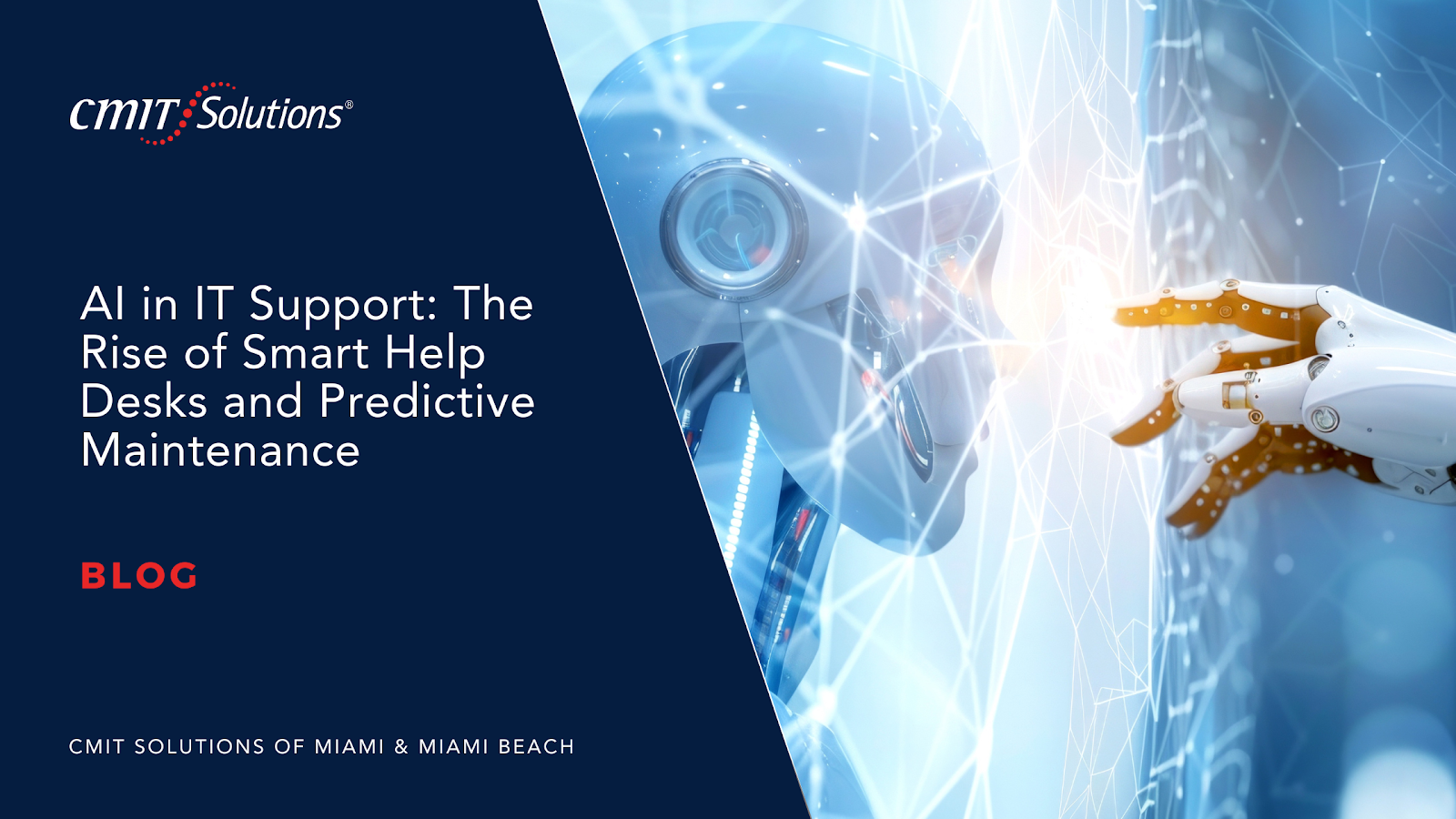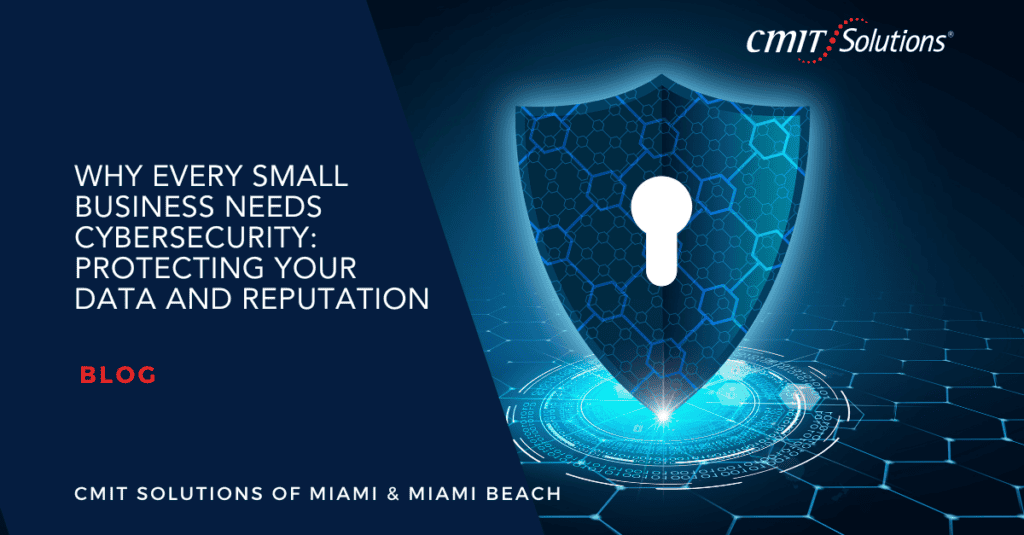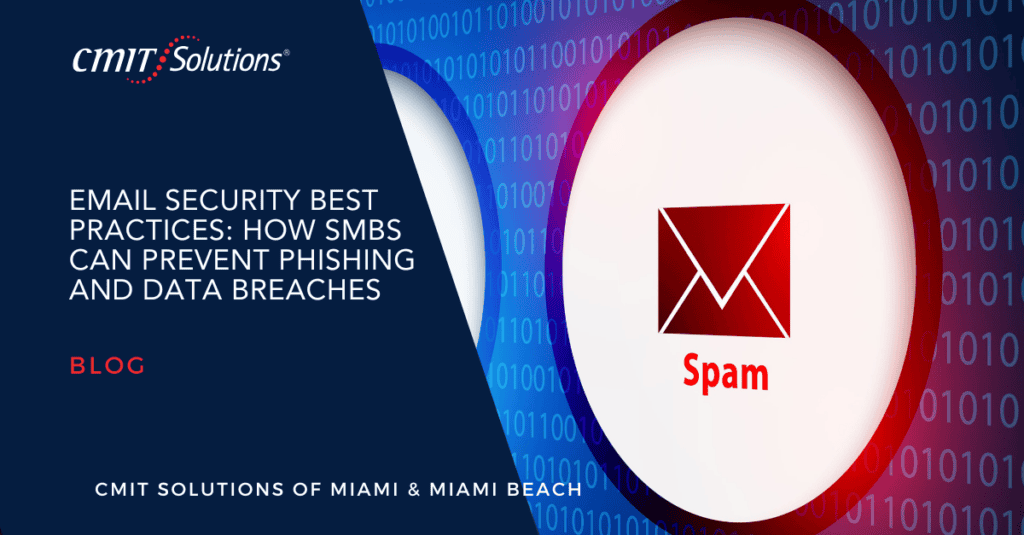Introduction: The Pressure to Leave Reactive IT Behind
In South Florida’s hyper‑competitive market, small and midsized businesses (SMBs) that still rely on manual ticket queues and wait‑until‑it‑breaks hardware strategies are running out of road. The break‑fix model—once acceptable when workloads lived on a single server in the back closet—can no longer deliver the resilience, productivity, and insight that modern teams expect. CMIT Solutions of Miami & Miami Beach has watched this transformation unfold across hundreds of client networks. Today, game‑changing advances in artificial intelligence (AI) have reached the help desk and the server room, ushering in smart help desks that resolve issues before humans even notice them and predictive maintenance engines that schedule fixes long before downtime hurts revenue.
But AI is not a magic wand. To unlock its full potential, Miami business leaders must understand the technologies, implement best‑practice security, and build a roadmap that aligns with long‑term growth goals. This 3,000‑word guide explores how AI‑driven IT support works, why the clock is ticking on reactive maintenance, and how your organization can start the journey—confidently and securely.
Why AI Is Reshaping the Help Desk for South Florida SMBs
Traditional support channels depend on people creating tickets, describing problems, and waiting in line for human technicians. That paradigm is too slow for hybrid workforces that demand 24/7 connectivity, and it scales poorly when your business adds new cloud apps every quarter. An AI‑enabled help desk solves both pain points by continuously monitoring endpoints, logs, and user behavior, escalating only the incidents that require human judgment.
- Instant triage & classification. Natural‑language processing engines analyze ticket text and route issues to the right specialist, accelerating mean time to resolution (MTTR).
- Self‑healing automations. When a user’s laptop reports a known service degradation, scripts triggered by AI apply the fix silently—no ticket, no phone call.
- Context‑aware responses. Chatbots trained on your knowledge base provide real‑time, company‑specific answers, freeing human agents for higher‑value work.
Crucially, a smart help desk still puts people first. This is a key differentiator for businesses evaluating whether to switch from break-fix to a managed model that scales with demand.. Instead of replacing technicians, AI augments them with data‑driven insights. That augmentation is a core pillar of the managed IT services model that many Miami businesses adopt to stay lean without sacrificing expertise.
Internal Pressures Driving Change
- Cyber risk is accelerating. Florida reports more ransomware incidents per capita than any other state. The most effective defense layers intelligent detection on top of robust cybersecurity best practices.
- Hybrid work is permanent. Employees expect lightning‑fast remote support, especially those in hybrid setups using tools explored in our guide to securing hybrid workforces.; legacy help desks can’t keep up with the volume.
- Compliance standards tighten yearly. Regulations such as HIPAA and the Florida Information Protection Act demand documented, proactive controls—a natural fit for AI‑driven logging and alerting.
Failing to evolve isn’t just inconvenient; it’s expensive. Gartner estimates that unplanned downtime costs SMBs an average of $5,600 per minute, a figure confirmed by the local experiences documented in our article on why downtime is costly for small businesses.
Anatomy of a Smart Help Desk
A modern AI help desk combines several interlocking technologies:
- Natural‑Language Processing (NLP). Converts user emails, chat messages, and voice calls into structured data the engine can understand.
- Machine‑Learning (ML) Classification. Learns from historical tickets to predict severity, category, and optimal resolution path.
- Automation & Scripting Framework. Executes pre‑approved remediation sequences—reboots, patch installs, configuration pushes—without human intervention.
- Knowledge Graph. Maps relationships between assets, software versions, and previous fixes, so the system can reuse proven solutions.
- Human‑in‑the‑Loop Review. Skilled engineers oversee AI decisions, refining models and handling novel edge cases.
When CMIT Solutions of Miami & Miami Beach deploys a smart help desk, the backbone often integrates with Microsoft 365 productivity tools and with our secure remote‑monitoring agents. The result: a single pane of glass that identifies issues, applies fixes, and documents every step for compliance purposes.
Predictive Maintenance: Moving From Break‑Fix to Foresee‑Fix
If AI help desks solve the “people problems” of IT support, predictive maintenance tackles the “machine problems.” By continuously ingesting telemetry—CPU temperature, disk health, network latency—machine‑learning models forecast the probability of failure days or weeks in advance. That foresight lets technicians swap a dying hard drive at 2 a.m., not 2 p.m. on payroll day.
How Predictive Maintenance Works
- Data Collection. Edge agents capture real‑time metrics and forward them to a secure cloud.
- Feature Engineering. Algorithms transform raw data into meaningful indicators (e.g., read‑error rates, patch age).
- Anomaly Detection. Statistical baselines flag deviations before humans perceive symptoms.
- Failure Prediction. Supervised ML models assign risk scores to each asset; high‑risk items trigger work orders.
- Automated Remediation. Scripts or technicians perform targeted maintenance—patching, part replacement, workload migration.
This methodology underpins our guidance on proactive IT maintenance and monitoring. It also aligns with industry analyses showing that predictive analytics can reduce maintenance costs by 30% and eliminate 70% of unplanned outages.
The Security Multiplier
Predictive maintenance isn’t just about hardware longevity; it’s also a cybersecurity powerhouse. By mapping patch currency across every endpoint, the system highlights “islands of risk” such as unpatched VPN appliances—common pivot points for attackers. Our recent deep dive into endpoint detection and response (EDR) solutions explains how real‑time analytics and automated containment stop lateral movement in seconds.
Security Imperatives: AI‑Augmented Defense
A smarter help desk is only valuable if it’s secure. AI introduces new attack surfaces—model poisoning, prompt injection, data exfiltration via overly permissive chatbots. CMIT Solutions of Miami & Miami Beach mitigates these risks through a multilayered strategy:
- Zero‑Trust Architecture (ZTA). Validate every device, user, and application request. Our article on SIEM solutions like Microsoft Sentinel shows how centralized telemetry supports ZTA.
- Continuous Monitoring. 24/7 network operations centers (NOCs) leverage AI to surface anomalies, fulfilling the promise of round‑the‑clock support.
- Secure Development Lifecycle. All automation scripts undergo peer review and sandbox testing before production deploys.
- Encryption & Data Governance. Role‑based access controls thwart internal threats, while encrypted channels protect data in transit and at rest.
These pillars prevent the nightmare scenario described in our warning about the hidden costs of poor IT support.
Case Study: A Miami Manufacturer Shortens Downtime by 87%
A 150‑employee precision‑machining company faced chronic CNC controller failures that halted production twice a month. After adopting CMIT Solutions of Miami & Miami Beach’s predictive maintenance platform:
- Risk scoring identified specific servo drives with overheating patterns.
- Preemptive replacements occurred during scheduled weekend windows, eliminating surprise outages.
- AI help desk chatbots provided technicians with step‑by‑step playbooks on mobile devices.
In the first six months, overall downtime fell from 14 hours to 1.8 hours—a direct boost of $74,000 in recoverable revenue. The story echoes themes explored in our guide on preventing costly disruptions and avoiding the hidden costs of IT gaps.
Getting Started: Building an AI‑Ready Foundation
Implementing smart support is easier when you have clear milestones:
- Assessment & Inventory. Map every asset and dependency; uncover legacy systems still on Windows Server 2012.
- Quick‑Win Automations. Start with high‑volume pain points like password resets, drawing on lessons from break‑fix transitions.
- Data Hygiene. Consolidate logs into a centralized platform; remove duplicate schemas.
- Pilot & Iterate. Deploy AI ticket triage in one department; measure MTTR and user satisfaction.
- Full Rollout & Continuous Improvement. Expand predictive maintenance across servers, endpoints, and IoT devices.
Our roadmap aligns closely with the framework described in the article on switching to managed services, which highlights scale advantages and mirrors the strategies in our disaster recovery readiness checklist.
Integrating AI With Your Existing Tech Stack
A common misconception is that AI support requires wholesale platform changes. In reality, most organizations can enhance existing investments:
- Microsoft 365 & Intune. Use built‑in analytics to inform device risk scoring, as explored in our discussion of Intune MDM.
- Azure & AWS CloudWatch. Feed cloud metrics directly into the predictive engine.
- Unified Communications (UCaaS). Correlate call‑quality data with network telemetry; our UC strategy primer on boosting collaboration explains the synergy.
- Backup & Disaster‑Recovery Platforms. Automate test restores, guided by insights from our article on robust DR plans.
When these tools share a common data model, AI can reason across silos—a cornerstone of the multi‑layered cybersecurity approach advocated by our security architects.
Workforce Empowerment: Training Humans to Work With AI
Successful adoption hinges on people:
- Change Management. Communicate why smart help desks matter—faster resolutions and fewer midnight calls.
- Upskilling. Provide technicians with certifications in Python, data analytics, and AI service operations.
- Security Awareness. Reinforce phishing‑resistant habits via our email security best practices program, ensuring users trust but verify AI‑generated suggestions.
- Culture of Experimentation. Encourage feedback loops; every ticket becomes training data for a better model.
These steps reduce “AI anxiety” and foster a partnership between humans and machines. Many of these shifts are discussed in our playbook on smart IT collaboration tools. and foster a partnership between humans and machines.
Business Agility and Competitive Advantage
AI-enabled IT support isn’t just about efficiency—it’s about giving your business a competitive edge in a fast-moving digital economy. When smart help desks resolve problems before they’re noticed and predictive maintenance eliminates costly interruptions, your organization becomes more responsive, more resilient, and better positioned for growth.
Instead of being bogged down by repetitive tasks and IT bottlenecks, your team can focus on strategic initiatives. IT becomes an enabler of innovation rather than a reactive expense. By removing friction from daily workflows, AI allows leaders to test, scale, and launch faster—whether it’s rolling out new customer tools or expanding operations across markets.
Our work with fast-scaling businesses shows that organizations embracing AI see faster onboarding, greater employee satisfaction, and improved customer trust. These outcomes mirror findings from our article on technology-driven resilience, which explains why adaptability is the new competitive currency.
Future Outlook: Where AI Support Is Headed by 2027
- Federated Learning. Models will train across distributed data sets without exposing sensitive information.
- Conversational AI‑DevOps. Voice assistants will deploy patches and spin up test environments on command.
- AI‑Generated Playbooks. Large language models will auto‑draft remediation runbooks, updating them as threats evolve.
- Predictive Compliance. Systems will flag upcoming regulatory changes and map control gaps automatically.
Businesses that embrace these advances early will outpace peers still trapped in reactive cycles—a key message in our visionary piece on technology‑driven resilience.
Conclusion: The Clock Is Ticking—Act Before Downtime Strikes
AI‑driven help desks and predictive maintenance shift IT from a cost center to a growth catalyst. They free employees from repetitive troubleshooting, safeguard critical data, and turn compliance from a headache into a strategic advantage. Yet the window for easy competitive gains is narrow; once these capabilities become table stakes, late adopters will struggle to catch up.
CMIT Solutions of Miami & Miami Beach stands ready to co‑create an AI roadmap tailored to your unique environment—grounded in proven frameworks, fortified by industry‑leading security, and measured against the metrics that matter most to your executive team. If you’re ready to take the next step, reach out to our team today to start the conversation before the next outage reminds you that in IT (and in business), waiting is the most expensive decision of all.







